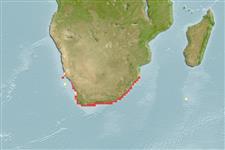Environment: milieu / climate zone / depth range / distribution range
Ökologie
seewasser; süßwasser; brackwasser. Subtropical; 27°S - 35°S
Southeast Atlantic: restricted from Lüderitz, Namibia to northern Natal, South Africa.
Length at first maturity / Size / Gewicht / Alter
Maturity: Lm 4.0 range ? - ? cm
Max length : 11.0 cm SL Männchen/unbestimmt; (Ref. 7248)
Rückenflossenstacheln (insgesamt) : 6 - 9; Rückenflossenweichstrahlen (insgesamt) : 11 - 15; Afterflossenstacheln: 1; Afterflossenweichstrahlen: 15 - 18. Body silvery and translucent with a midlateral band; dusky upper surface (Ref. 4125).
Forms schools along the coast and in estuaries, especially during spring (Ref. 3302). Also found in coastal lakes (Ref. 7248). Small individuals filter out small organisms such as phytoplankton and rotifers. Above 3.5 cm TL, it feeds mostly on crustaceans especially amphipods taken from the water column as well as off the bottom. Preyed upon by fishes and birds (Ref. 7248).
Life cycle and mating behavior
Maturities | Fortpflanzung | Spawnings | Egg(s) | Fecundities | Larven
Skelton, P.H., 1993. A complete guide to the freshwater fishes of southern Africa. Southern Book Publishers. 388 p. (Ref. 7248)
IUCN Rote Liste Status (Ref. 130435)
Bedrohung für Menschen
Harmless
Nutzung durch Menschen
Fischereien: kleinfischerei; Köder: usually
Tools
Zusatzinformationen
Download XML
Internet Quellen
Estimates based on models
Preferred temperature (Ref.
123201): 14.3 - 23.9, mean 19.5 °C (based on 14 cells).
Phylogenetic diversity index (Ref.
82804): PD
50 = 0.5312 [Uniqueness, from 0.5 = low to 2.0 = high].
Bayesian length-weight: a=0.00776 (0.00426 - 0.01415), b=3.14 (2.97 - 3.31), in cm total length, based on LWR estimates for this species & (Sub)family-body (Ref.
93245).
Trophic level (Ref.
69278): 3.4 ±0.46 se; based on food items.
Widerstandsfähigkeit (Ref.
120179): mittel, Verdopplung der Population dauert 1,4 - 4,4 Jahre. (Preliminary K or Fecundity.).
Fishing Vulnerability (Ref.
59153): Low vulnerability (10 of 100).
